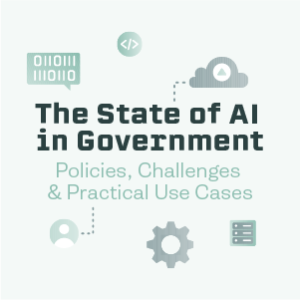For government employees looking to build successful and satisfying careers in public service, the curriculum is changing. It’s not enough to develop mastery of agency processes and policies or to stockpile continuing education credits on traditional core competencies. Instead, public servants need to develop a working knowledge of current trends in IT and management that are reshaping how government operates. IT and management: That’s the operative phrase. Technology is continually improving the efficiency of work processes and the productivity of employees. But efficiency and productivity only go so far. It’s at the intersection of technology and management that real change is happening. Agencies are gaining new insights into their operations and services, and using those insights to fuel innovations across their organizations. Government employees at all levels have the opportunity to be part of this transformation, but they need to get up to speed on the key trends. Where are they to begin? Download the guide to read more about four competencies that could be critical to the careers of public servants.
Edge Computing Raises Ransomware Risk
“The problem is that edge computing – in which data is being aggregated, accessed or processed outside the network perimeter – is leaving data exposed to cyber criminals who see an opportunity to make money through ransomware schemes. According to Gartner, a research and consulting firm, edge computing will grow 75% by 2025. In government, the surge is being fueled both by a growth in end-user devices in mobile and remote computing and in non-traditional devices associated with the Internet of Things (IoT) and operational technology (OT), such as sensors and cameras. In many cases, agencies support edge computing by moving data into the cloud, rather than requiring end-users or devices to go through the data center. This hybrid cloud environment mitigates performance and latency problems but also makes the network perimeter even more porous.”
Read more insights from HPE’s Distinguished Technologist for Cyber Security, James M.T. Morrison.
Agencies Need to Maintain a Sense of Cyber Urgency
“Security isn’t just the responsibility of individuals. Agencies also must ensure they treat security as a top priority. SolarWinds recommends two areas of focus: Prioritize the development of cyber experts. Given the high demand for cyber experts, agencies should focus more energy on developing talent in house. Shopp said one approach is to convert IT professionals, who are already tech savvy, into cyber professionals. Prioritize collaboration between tech pros and leaders. Policies and strategies aimed at reducing risk should reflect both technical and organizational expertise and requirements. Shopp said agencies also should collaborate more with trusted industry partners. SolarWinds, for example, isn’t just a technology vendor; it also has a large development shop, as many government agencies do, and can exchange ideas about cyber strategies, tools, and best practices.”
Read more insights from SolarWinds’ Group Vice President of Product Management, Brandon Shopp.
 How to Move DevOps from Disarray to Unity
How to Move DevOps from Disarray to Unity
“An agency’s initial forays into integrating their development and operations teams can bear fruit quickly, leading to better quality software produced at a faster clip. The risk is that an organization will treat its initial forays as the endgame, not realizing that a more mature approach, with greater payoffs, is possible. In short, the DevOps initiatives never grow up. GitLab, which has years of experience helping organizations with DevOps adoption, has identified four stages in a DevOps journey, culminating in an approach that delivers even greater benefits than envisioned at the outset.”
Read more insights from GitLab’s Federal Solutions Architect, Sameer Kamani, and Senior Public Sector Solutions Architect, Daniel Marquard.
Why Stronger Security Hinges on Identity Data
“To understand the need for an Intelligent Identity Data Platform, consider two scenarios. In the first case, a user logs into an application from her office at 2 p.m. each day. In this case, she will be considered a low risk, based on three factors: Her credentials, her usage patterns and location data. In the second scenario, this same user logs into the application from her office but at 2 a.m. The aberration in her routine (i.e., usage pattern) raises a red flag, as would a change in her location. Even this simple use case requires an agency to have a holistic picture of an end-user, which is not possible without a central platform.”
Read more insights from Radiant Logic’s Vice President of Solutions Architects and Senior Technical Evangelist, Wade Ellery.
The Case for Data Literacy
“Someone who works in national defense requires different data skills from those in environmental or financial management auditing. ‘We firmly believe it’s not a one-size-fits-all approach,’ Ariga said. Training must be catered to tradecraft. It’s the reason GAO is creating its own data literacy curriculum specific to the oversight community, instead of relying on third-party training that focuses on generic, often commercial aims. Additionally, the best time for people to learn data skills is when they actually need them. On-demand tools such as microlearning videos and a walk-in Genius Bar ensure staff can access data solutions and build literacy when they need, instead of waiting months to register for a class.”
Read more insights from the Government Accountability Office’s Chief Data Scientist and Director of the Innovation Lab, Taka Ariga.
The Future of AI Hangs on Ethics, Trust
“Over the next five years or so, we could see a revolution in the use of AI, Sivagnanam said. Think about the self-driving car industry. At this point, human drivers are still a necessary part of the equation. But AI pioneers are hard at work trying to change that, and quickly. Similar advances are likely in other applications of AI. Over the next three to five years, Sivagnanam hopes to see the AI industry mature. As part of that, he expects to see the development of regulations and guidelines around AI and ethics, both from the federal government and from industry organizations. That work is already getting underway, and NSF is playing a role. Through a grants program called Fairness in Artificial Intelligence (FAI), NSF supports researchers working on ethical challenges in AI.”
Read more insights from the U.S. National Science Foundation’s Chief Architect, Chezian Sivagnanam.
Q&A: Getting Schooled on Zero Trust Security
“Zero trust means zero trust. We’re monitoring your internal systems. To an extent, we are monitoring what individuals are doing. That’s not to say we’re Big Brother. We’re not monitoring the keystrokes of every user in the state or anything like that. For the agencies, multi-factor [authentication] is a huge one. We’ve seen time and time again accounts get compromised because they had a bad username and password. If that’s the only thing protecting a system, that’s not enough. The bottom line is we know people create bad passwords. That’s a given. You can increase awareness about how to create good passwords, and you certainly want to try that. In many cases, people will just figure out ways around complexity requirements to get an easy-to-remember password versus a secure and strong password. You want to encourage people to have unique passwords for every single site. At some point, you need to give them a secure method of being able to remember all these passwords.”
Read more insights from Connecticut’s CISO, Jeff Brown.
3 Tenets for Advancing Equity in Your Everyday Work
“If there were one thing you could do to eliminate health disparities or advance health equity, what would it be? This is a question that Dr. Leandris Liburd gets asked often, but it’s not one she’s fond of. The answer isn’t a simple one, and the COVID-19 pandemic has magnified that truth. There isn’t a magic pill to ensure that no one is denied the possibility of being healthy because they belong to a group that has been economically or socially disadvantaged. And measuring success is about more than data points. Choosing one thing to advance health equity ‘is not possible when you’re dealing with these kinds of complexities,’ Liburd said in an interview with GovLoop. ‘So we have to do a lot of things at the same time.’”
Read more insights from the CDC’s Director of the Office of Minority Health and Health Equity, Dr. Leandris Liburd.
Download the full GovLoop Guide for more insights from chief information officers, a chief data scientist and other senior leaders in federal, state and local government.

 Anxious residents make appointments with retail vendors as well as states. If a resident gets a retail appointment first, they usually won’t cancel the state appointment. Vaccines must be administered within four to six hours; numerous no-shows risk wasting vaccine. Vaccination capacity is not achieved if appointment times are left unfilled, and this has a negative impact on the whole process.
Anxious residents make appointments with retail vendors as well as states. If a resident gets a retail appointment first, they usually won’t cancel the state appointment. Vaccines must be administered within four to six hours; numerous no-shows risk wasting vaccine. Vaccination capacity is not achieved if appointment times are left unfilled, and this has a negative impact on the whole process. Putting the Public First
Putting the Public First 3 Ways Cloud Improves AI
3 Ways Cloud Improves AI